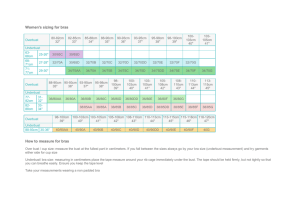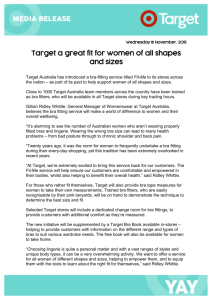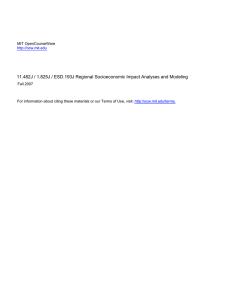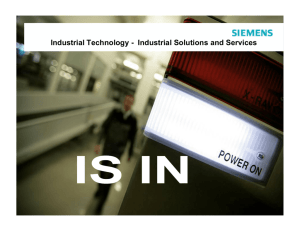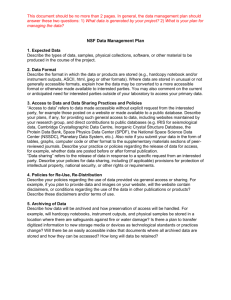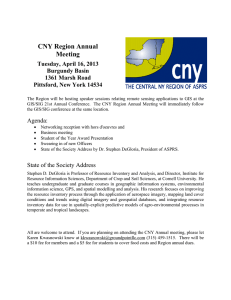11.914 Followup Amanda and Frank spoke with Susan on the phone on... Gateway: Planning Communication
advertisement
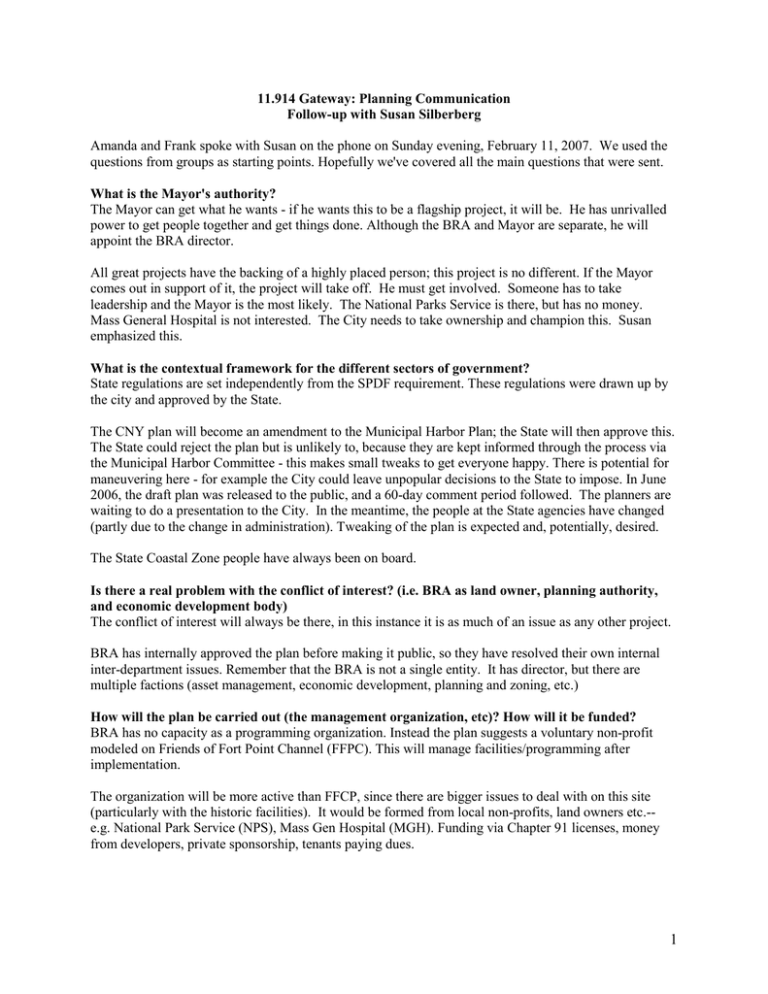
11.914 Gateway: Planning Communication Follow­up with Susan Silberberg Amanda and Frank spoke with Susan on the phone on Sunday evening, February 11, 2007. We used the questions from groups as starting points. Hopefully we've covered all the main questions that were sent. What is the Mayor's authority? The Mayor can get what he wants ­ if he wants this to be a flagship project, it will be. He has unrivalled power to get people together and get things done. Although the BRA and Mayor are separate, he will appoint the BRA director. All great projects have the backing of a highly placed person; this project is no different. If the Mayor comes out in support of it, the project will take off. He must get involved. Someone has to take leadership and the Mayor is the most likely. The National Parks Service is there, but has no money. Mass General Hospital is not interested. The City needs to take ownership and champion this. Susan emphasized this. What is the contextual framework for the different sectors of government? State regulations are set independently from the SPDF requirement. These regulations were drawn up by the city and approved by the State. The CNY plan will become an amendment to the Municipal Harbor Plan; the State will then approve this. The State could reject the plan but is unlikely to, because they are kept informed through the process via the Municipal Harbor Committee ­ this makes small tweaks to get everyone happy. There is potential for maneuvering here ­ for example the City could leave unpopular decisions to the State to impose. In June 2006, the draft plan was released to the public, and a 60­day comment period followed. The planners are waiting to do a presentation to the City. In the meantime, the people at the State agencies have changed (partly due to the change in administration). Tweaking of the plan is expected and, potentially, desired. The State Coastal Zone people have always been on board. Is there a real problem with the conflict of interest? (i.e. BRA as land owner, planning authority, and economic development body) The conflict of interest will always be there, in this instance it is as much of an issue as any other project. BRA has internally approved the plan before making it public, so they have resolved their own internal inter­department issues. Remember that the BRA is not a single entity. It has director, but there are multiple factions (asset management, economic development, planning and zoning, etc.) How will the plan be carried out (the management organization, etc)? How will it be funded? BRA has no capacity as a programming organization. Instead the plan suggests a voluntary non­profit modeled on Friends of Fort Point Channel (FFPC). This will manage facilities/programming after implementation. The organization will be more active than FFCP, since there are bigger issues to deal with on this site (particularly with the historic facilities). It would be formed from local non­profits, land owners etc.­­ e.g. National Park Service (NPS), Mass Gen Hospital (MGH). Funding via Chapter 91 licenses, money from developers, private sponsorship, tenants paying dues. 1 NPS would probably be the lead programming partner (like the Children’s Museum is for Fort Point). They have no financial resources to contribute (most of their budget goes on security for the USS Constitution). Unlikely to be conflict between the NPS and the management organization. MGH would need to be persuaded that involvement is worthwhile. Thus far, they have not been very involved, since they see no benefit to contributing. This organization needs to be set up ­ some existing organizations are compromised by previous positions. (There is currently a Friends of the Navy Yard organization that was formed in opposition to development). It takes time, leadership, and resources—a fresh DUSP graduate should go and sort it out! If the organization is set up and the Mayor is in support, it will be possible to get going. At the moment everything is waiting for this organization to emerge, no one else at present is capable of doing it. What consultation has the BRA carried out? How did the consultation process work? Community involvement? Outreach to Charlestown? A lot of consultation ­ more than half of meetings held in Charlestown (at the Knights of Columbus Hall in the Uptown neighborhood) not in the CNY. Local newspaper given all info after meetings. BRA neighborhood planner (Carlos Montanez, a DUSP grad) led the outreach. Other Boston wide bodies involved ­ Conservation Law Foundation, Save The Harbor Save The Bay, etc. Boston Harbor Association attended every meeting. Interesting to compare with South Boston ­ there, the neighborhood had a strong emotional attachment to the waterfront and took an active role in development planning. Charlestown is less passionate; it comes down to topics like parking. The plan is designed for a wide constituency, including Charlestown residents. Tourism elements are good, but key point is universal access to the Harborwalk. In general, there is broad support for the plan (story loops, etc.)—it’s just that the Charlestown residents are not emotionally invested in the area and feel no attachment to the Navy Yard. SPDF clarifications Buildings are required to have FPA space on the first floor, which can be used for restaurants, retail, etc. (but not housing or office space). Since no restaurants or shops want to move out to the CNY right now, there are a lot of buildings with vacant ground floor space. Parcel 4 has 20,000 sq. ft. of empty FPA. For a clear breakdown of the $100 per sq. ft. SPDF issue for Pier 5, see page 59 of the Waterfront Activation Plan. The planners want all the SPDF space to be built­out (i.e. ready for use). The developer must provide SPDF space rent­free and with free utilities for the lifetime of the license. The plan seeks to spread out the 34,000 sq. ft. of state­mandated SPDF around the CNY (several small attractions rather than 1 big museum). The idea is to get a critical mass of cultural SPDF spots so that then restaurants and retail will be attracted to the FPA space to revitalize the CNY. The reserved SPDF space must be interior space (this is a problem for CNY since some attractions are outdoorsy, but good because attractions will be more year­round). SPDF has no formal definition but it needs to be a major attraction (e.g. moving the Aquarium, except that the Aquarium can't afford this). The proposed Maritime Interactive Park (story loops, etc.) would probably count as a SPDF. 2 The example of Building 114: FPA never filled in MGH building and it has been empty for 6 years. Nothing for the public, MGH not exerting themselves to fill it. So the idea of spreading out the spaces and making the developer offer rent­free space is to avoid more empty spaces. Several smaller sites will make a network of places to visit. Can see no other way of doing this unless the BRA builds, fits out, and offers the site. Spalding rehab center is committed to coming to the site and it is a great use for the site. Lots of activity, staff, patients etc. What about the Moran AutoPort (MassPort facility across the channel from our site)? This is staying. Bulk cargo (like automobiles) is one of the successful areas for MassPort, so different uses for that site are not under consideration. 3
